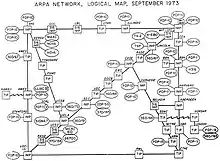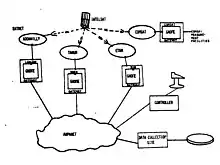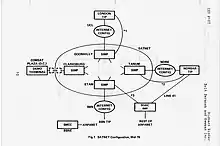SATNET
SATNET, also known as the Atlantic Packet Satellite Network, was an early satellite network that formed an initial segment of the Internet. It was implemented by BBN Technologies under the direction of the Advanced Research Projects Agency.




History
SATNET had its origins in Larry Roberts' 1970 proposal for a link between the ARPANET and the National Physical Laboratory (NPL) network. The NPL network was developed by Donald Davies, one of two independent inventors of the concept of packet switching. ARPA had an existing 2.4 kilobit/second link to NORSAR (used for seismic research), which at the time passed through a satellite station in the UK, then continued via cable to Norway.[1]
In 1971 Peter T. Kirstein was chosen instead to connect his research group at University College London (UCL). Funding was finally approved in 1973, by which time the trans-Atlantic connectivity had changed: the NORSAR link now crossed the Atlantic via the Nordic satellite station in Tanum, Sweden, then continued via cable to Norway.[2] Two ARPANET Terminal Interface Processors (TIPs) were installed in Norway and connected to the ARPANET via satellite in June and September 1973. The TIP for UCL also arrived in September 1973, and its connection via a terrestrial circuit to Norway became operational in July 1973 at 9.6 kilobits/second. At this point, UCL was connected to the ARPANET, the first heterogeneous interconnected network. UCL later provided a gateway for an interconnection with the NPL network and subsequently the SRCnet, the forerunner of UK's JANET network.[1]
In that same year, Larry Roberts proposed that it would be possible to use a satellite's 64 kilobit/second link as a medium shared by multiple satellite earth stations within the beam's footprint. This proposal was implemented by Bob Kahn, and resulted in SATNET. Key participants included BBN Technologies, COMSAT, the Linkabit Corporation, UCLA, University College London, the Norwegian Defence Research Establishment and the Royal Signals and Radar Establishment in Britain. By the late 1970s, SATNET connected research sites in the US, UK, Norway, Germany, and Italy.
SATNET played a central role in the creation of the Internet protocol suite. In 1973, Bob Kahn designed the interconnection of the ARPANET with other networks. He enlisted Vint Cerf, who was teaching at Stanford. The problem is that the ARPANET, radio-based PRNET, and SATNET all had different interfaces, packet sizes, labelling, conventions and transmission rates. Linking them together was very difficult. In response, Kahn and Cerf set about designing a net-to-net connection protocol. Cerf led the newly formed International Networking Working Group (INWG). In September 1973, the two gave their first paper on the new Transmission Control Program at an INWG meeting at the University of Sussex in England. Their proposal, published the next year, incorporated concepts developed by Louis Pouzin and Hubert Zimmermann, designers of the CYCLADES network.[3][4]
SATNET was assigned the 4.x.x.x/8 IPv4 address range in the List of assigned /8 IPv4 address blocks.
In later years, J. C. R. Licklider remembered the difficulty in arranging such satellite links during his second ARPA tour:[5]
When I was [at ARPA in 1974-1975], we were trying to set up a satellite link with Britain, and to deal with British General Post Office, or whatever that's called, was just a totally different experience to me from anything else. They wanted us to buy insurance covering their whole plant, practically, in case our IMPs set fire, or something, to their equipment. It was really weird. Their worst fear was that somebody in Europe would call up, through some kind of a network, to a British Telephone installation, and get through it into the Atlantic link and get to the United States, and somehow bypass the fifteen cent toll, and, "Christ," I said, "this is just a research and development thing. If we can make it work, if it really turns out to be a great idea, we can figure out about rates and stuff." We wanted to extend an Arpanet link -- we needed in a desperate way to extend the Arpanet link to Stuttgart, and to some American military base down there -- I forget the name of it -- and they would never let us have the one little link.
See also
References
- Kirstein, P.T. (1999). "Early experiences with the Arpanet and Internet in the United Kingdom". IEEE Annals of the History of Computing. 21 (1): 38–44. doi:10.1109/85.759368. ISSN 1934-1547. S2CID 1558618.
- "ARPANET - NORSAR". www.norsar.no. Retrieved 2020-02-17.
- Cerf, V.; Kahn, R. (1974). "A Protocol for Packet Network Intercommunication" (PDF). IEEE Transactions on Communications. 22 (5): 637–648. doi:10.1109/TCOM.1974.1092259. ISSN 1558-0857.
The authors wish to thank a number of colleagues for helpful comments during early discussions of international network protocols, especially R. Metcalfe, R. Scantlebury, D. Walden, and H. Zimmerman; D. Davies and L. Pouzin who constructively commented on the fragmentation and accounting issues; and S. Crocker who commented on the creation and destruction of associations.
- "The internet's fifth man". Economist. 13 December 2013. Retrieved 11 September 2017.
In the early 1970s Mr Pouzin created an innovative data network that linked locations in France, Italy and Britain. Its simplicity and efficiency pointed the way to a network that could connect not just dozens of machines, but millions of them. It captured the imagination of Dr Cerf and Dr Kahn, who included aspects of its design in the protocols that now power the internet.
- "Interview of Joseph Carl Robnett (J.C.R.) Licklider", by James Pelkey, Computer History Museum, June 28, 1988, page 7.
Further reading
- L.G. Roberts, "Dynamic Allocation of Satellite Capacity through Packet Reservation", Proc. NCCC, Vol. 42, pages 695-702, 1973.
- University College London ARPANET Project, Annual Report 1977, by Professor Peter T. Kirstein, April 1978.
- Bolt Beranek and Newman Inc., "Combined Quarterly Technical Report No. 29", May 1983, Prepared for the Defense Advanced Research Projects Agency.
- Peter T. Kirstein, "Early Experiences With the Arpanet and Internet in the United Kingdom", IEEE Annals of the History of Computing, Vol. 21, No. 1, 1999, pages 38-44.
- Pål Spilling, "The Internet Development Process: Observations and Reflections", History of Nordic Computing 3: Third IFIP WG 9.7 Conference, HiNC3, Stockholm, Sweden, October 18-20, 2010, Revised Selected Papers.
- Katie Hafner, Matthew Lyon, Where Wizards Stay Up Late: The Origins Of The Internet, Simon and Schuster, 1998, pages 221-226. ISBN 9780684832678.
